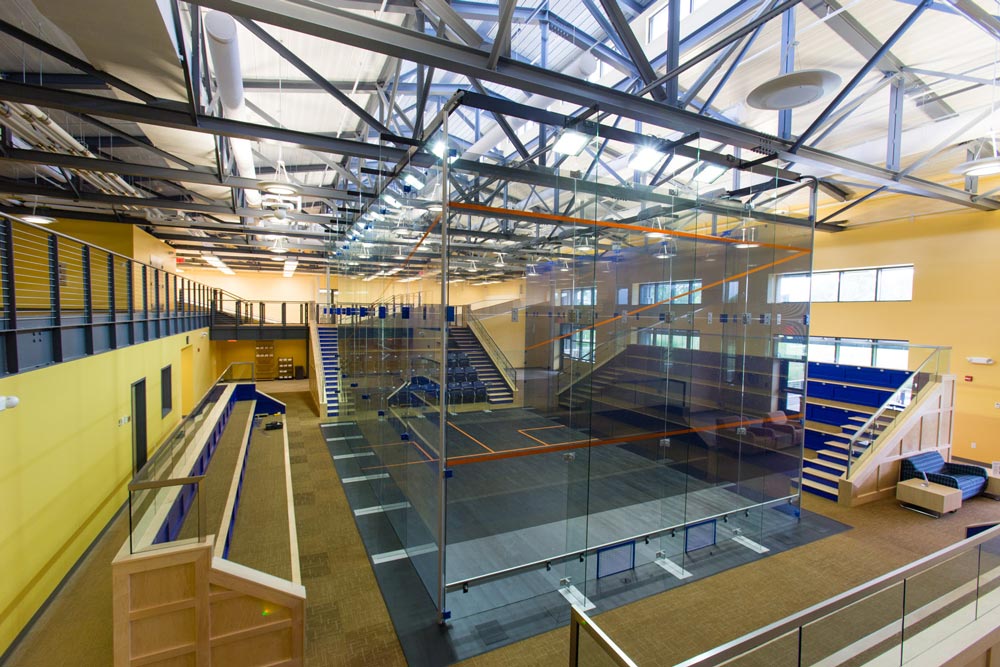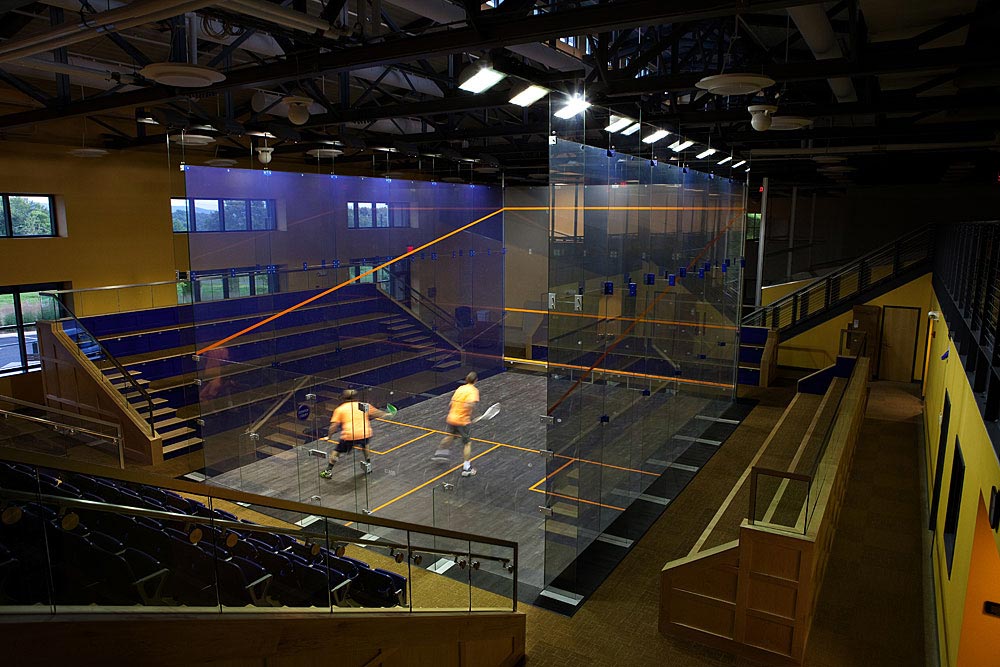Home-Court Advantage
New squash facility among the nation’s best
When it came time to choose colleges, Celia Dyer (Engr ’15) had a decision to make.
The squash standout had fallen in love with the sport during her time at Tabor Academy, a prep school in Marion, Mass., and she could have chosen to play for any number of New England colleges with nationally ranked varsity squash programs and stunning facilities.

Or there was UVA, which only had a club team that played on courts at a local high school.
After visiting Charlottesville, however, Dyer decided that UVA was the best fit for her, so she resigned herself to traveling off Grounds for practices and games.
“I was just happy they had a program,” says Dyer, a systems and information engineering and economics double major. “Just being able to play at any level of competition was important to me.”
But as luck would have it, Dyer now gets the best of both worlds.
This spring, UVA became home to the $12.4 million, 33,000-square-foot McArthur Squash Center at the Boar’s Head Inn, which is owned by UVA. The facility rivals those at more established programs like Yale or Harvard.
The world-class squash facility is not only the best in Charlottesville, says Francis Johnson, program director of the Quantitative Foundation—the financial muscle behind the facility—it’s among the best in the country.
“It’s really quite a gem, and the University makes a large statement that it wants to be in the conversation when it comes to squash,” says Johnson, a Charlottesville native and former Yale squash player.
The facility is the brainchild of Jaffray Woodriff (Com ’91), a hedge fund manager and owner of Quantitative Investment Management, a trading company. Woodriff’s charitable organization, the Quantitative Foundation, donated nearly $12 million toward the facility’s construction. It is named after Woodriff’s grandfather.

The gift is the largest the foundation has made since it was established in 2008, Johnson says, and speaks to how much Woodriff loves squash, which he picked up just six years ago, and his alma mater. “He’s really passionate about the sport,” Johnson says. “He wants to see this sport spread and is passionate about it and UVA.”
In 2011, Woodriff approached University officials about possibly building a world-class squash facility on Grounds through the foundation. By June 2012, construction had begun, and the facility officially opened in April.
The facility boasts nine international singles courts and two North American doubles courts and can accomodate more than 1,600 spectators for all of its courts.
But the highlight is the glass-walled international show court in the center of the facility that allows a keen view from any perch. Instead of the three solid walls with a white floor standard on most squash courts, the McArthur center court is all glass with a dark blue floor.
The floor allows the team to play with a white squash ball—making it easier for television cameras to follow the action.
“You don’t have to be a squash player to be entranced by the facility,” says James Neiderer, club manager at the Boar’s Head. “Everyone’s eyes light up and their jaws drop. It’s a phenomenal building.”
The squash world is taking notice. The facility recently won bids to host the 2014 U.S. National Championships and the Masters Squash Championships, and has renewed squash enthusiasts’ hopes that the sport will grow throughout the South.
“The ability to be able to hold events of all sizes from amateurs and juniors through to men’s and women’s professional events will further improve the profile of the game in Virginia by leaps and bounds,” says Alex Gough, president of the Professional Squash Association. “The vision of putting courts like these into new facilities is one that we would love to see across the country and indeed worldwide.”
It also opens up a new potential crop of students who could be interested in UVA.

Mark Allen, coach of UVA’s squash team and director of squash at Boar’s Head, says he’s already fielded calls and interviews with students around the country and internationally who heard about the new facility and wanted to learn more about UVA.
“A lot of squash players at these schools would be interested in a Southern-feeling school and up until now, there’s not been somewhere to do that,” Allen says. “We’re the first Southern school that offers squash and that’s creating a lot of interest. As we grow the program here, hopefully other ACC schools will start to take squash more seriously, too.”
Squash has held a place on Grounds as far back as the 1930s, when the Astor Squash Courts were first built next to Memorial Gym. Those courts were eventually converted into the Astor Tennis Pavilion, but Cavaliers could still play on recreational courts at Slaughter Gymnasium.
Informal teams came and went in the years that followed. The sport eventually picked up enough interest to form a dedicated men’s squash club team in 2001 and a women’s team in 2003. Club teams have coaches but don’t receive any financial backing from the University.
Both teams have taken home top squash championships over the years, including the Epps Cup and the Chaffee Cup in their divisions. The women’s team was ranked first among club teams, and 26th overall by the College Squash Association this past season, while the men’s team came in eighth among club teams, and 36th overall.
With the sustained interest in the sport, the University of Virginia was a “logical fit” for a squash facility, says Johnson. “Look at the squash landscape: It’s dominated by Ivy League schools,” he says. “UVA wants to compete against the best of the best on all levels—not just academic, but athletic. And squash creates a good opportunity for that.”
None of the Top 10 collegiate squash programs are south of the Mason-Dixon line. The College Squash Association, the governing body for intercollegiate squash, is headquartered in Massachusetts and was founded by Ivy League squash programs, Michael T. Bello, CSA executive administrator says.
“I was surprised when we heard UVA was going to build the facility,” Bello says. “And when I heard they were putting a glass court in, that’s what surprised me most. It’s not unheard of to build a couple of courts, but a glass court is extremely expensive, and UVA has stadium seating. It takes an extra commitment to do that.”

The University has no plans to move the team into Division I right now, but Allen, the coach, has zeroed in on broadening the squash program at the Boar’s Head. He has started up a number of summer camps and programs run out of the facility this year, and plans to begin an intramural squash team when classes resume in September.
And he wants to make both the men’s and women’s teams perennial club powerhouses. For the coming season, Allen says, having the McArthur Center not only gives the UVA team an advantage in playing white-ball squash, but it also means players can have more time to practice, since they won’t have to borrow time on the courts at nearby St. Anne’s Belfield School.
The potential the facility represents for UVA and the squash program is a thrilling prospect for students like Dyer.
“Squash players choose UVA for reasons other than squash,” Dyer says. “But eventually, we’ll be able to get any kind of great players. We’ll just be so unique from any other school that offers a squash program.”
While Dyer says the excitement is buzzing across Grounds—she’s been approached by more than one friend for squash lessons so they can play in the new facility—few are more excited than the current squash team.
Shortly before the facility opened officially in May, Dyer says, she snuck into the court to get a peek.
“We went on the center court and took pictures,” she says. “It was amazing. And it was a space that was built just for us.”